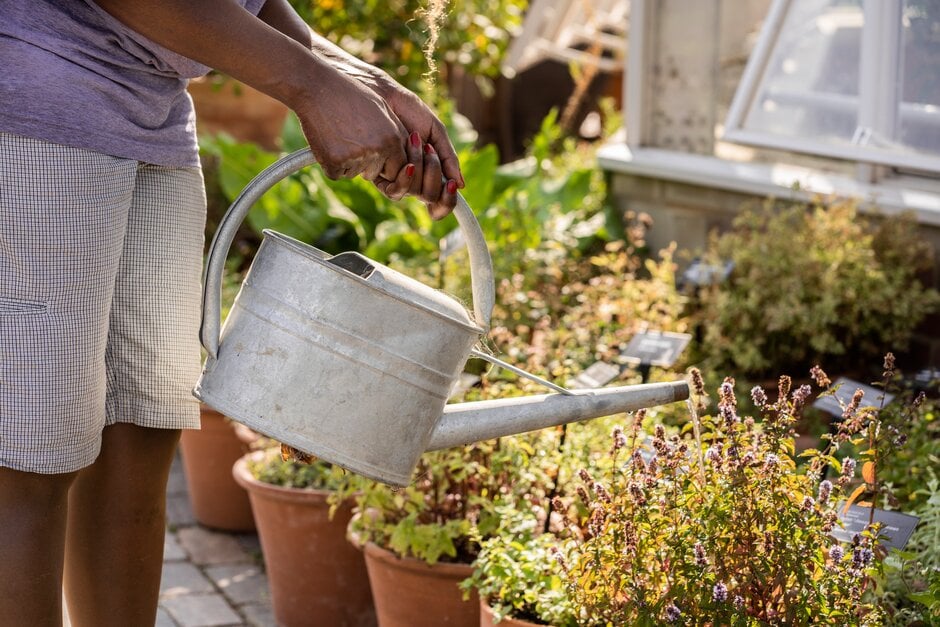How to water containers
The roots of container plants can only absorb water from the limited amount of compost they grow in, so they rely on us to provide enough to support healthy growth. Here you can learn how to water your container plants in six easy steps.

Quick facts
- Water container plants regularly through spring and summer. Evergreens may need watering year-round
- Watering thoroughly when needed, rather than little and often, encourages deep rooting and makes plants better able to withstand drought
- Compost loses its structure over time, making it less able to hold on to moisture, so repot regularly to keep plants growing well
Getting started
Don't worry if you're new to container gardening and not sure how often or how much you'll need to water. If you follow the steps below, checking moisture levels regularly, you will quickly be in tune with the needs of your plants.
To help you prioritise your plants' watering needs, bear in mind that:
- Young and newly-planted plants need watering regularly (often daily) in warm, dry weather
- Drought tolerant plants, like those with small, fleshy or silvery leaves, can be left longer between waterings
- Deep pots hold moisture longer than shallow ones
- Terracotta pots dry out quickly and metal ones heat up in the sunshine, baking the compost inside
- Containers in north and east-facing positons hold moisture longer than those in south and west-facing positions, as they aren't dried out by long spells of strong sunshine
What you’ll need to water your containers:
-
Watering can fitted with a fine rose
-
A hosepipe on a spray setting (where a watering can is impractical)
-
Saucers or drip trays (for summer use)
How to water containers in six simple steps
-
Plan to water early morning or early evening
Watering at the cooler times of day reduces the amount of water evaporating from the soil surface, meaning more is available to plant roots.
-
Check the moisture level of each container before you water
Use your finger to feel for the moisture level to about a third of the way down the pot. If it’s dry at that depth, then watering is needed.
Remember plants use and lose more water in warm, windy weather, and light rain and short showers are unlikely to wet the soil more than a few centimetres down, so watering may still be needed even if it has recently rained.
-
Fill your watering can to a manageable weight
It’s better for your back to do more trips with a lighter weight than struggle with a heavy can.
-
Water slowly and thoroughly to soak the compost
Pour on enough water to fill up to the rim of the pot and let that soak into the soil before repeating once more. Watering slowly, close to the pot, stops soil being disturbed and eroded.
-
Water the soil, not the foliage
This helps to avoid spreading disease spores, like those of rose black spot, and causing scorch damage on sensitive plants when droplets heat up in the sun. Water intercepted by the foliage also means less reaches the roots.
-
Stop watering before it runs out the bottom of the pot
Completely saturating the soil is not good nor needed for healthy plant growth, it wastes water and washes nutrients out of the soil. Aim to stop just before, or as soon as, you see water coming from drainage holes.
Aftercare
Watering can become a bit of a chore during the summer if you have lots of plants in pots, so it's worth considering methods of conserving moisture to make the task easier. These include grouping plants to raise local air humidity, standing pots in trays or saucers to catch any run-off and mulching pots to reduce water loss from the soil.
Just remember that roots need oxygen as well as water, so empty any trays and saucers a few hours after watering to prevent the compost becoming completely saturated. Remove them completely over winter.
If you have previously gardened in peat-based compost, you may need to water a little less heavily but more often in peat-free compost, but use the tips above to help you decide when your container needs some water.
Get involved
The Royal Horticultural Society is the UK’s leading gardening charity. We aim to enrich everyone’s life through plants, and make the UK a greener and more beautiful place.